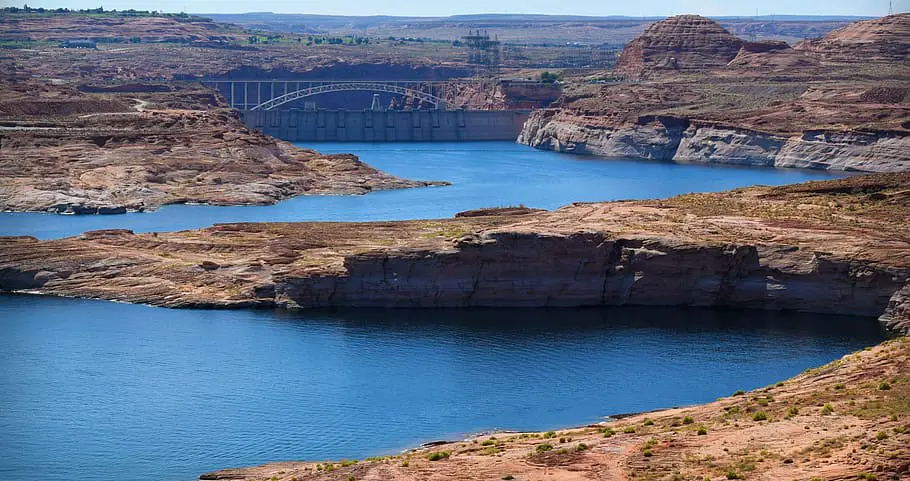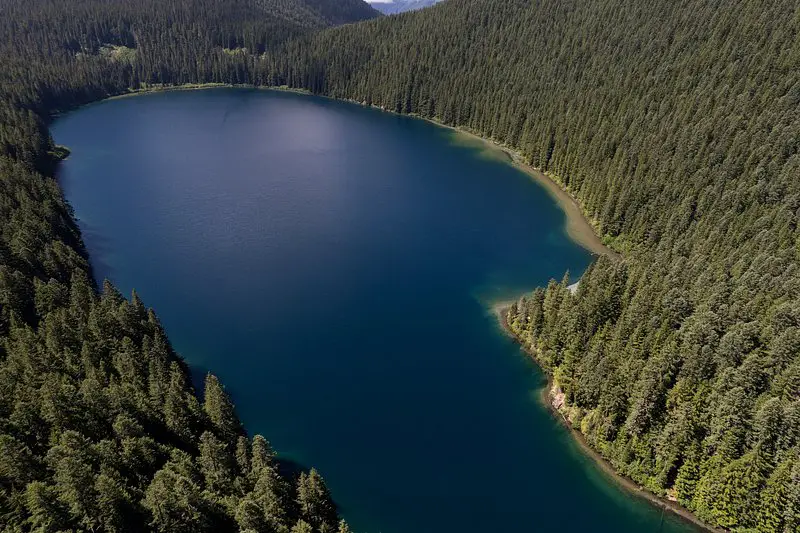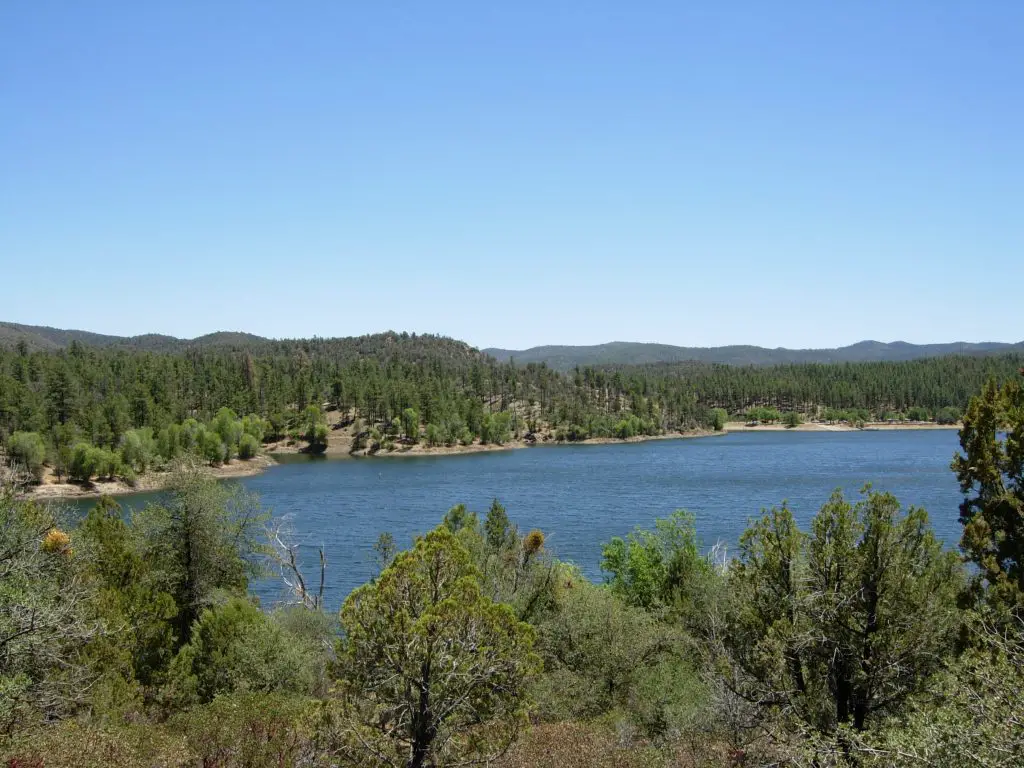Arizona, known for its desert landscape and towering cacti, surprisingly also hosts an impressive array of man-made lakes. The creation of these water bodies has provided an oasis in the arid climate, offering recreational opportunities, supporting wildlife, and acting as a lifeline for human sustenance.

As we explore the majesty of the man-made lakes in Arizona, you’ll discover a compelling story of human innovation and nature’s resilience.
Understanding Man-Made Lakes
A man-made lake, often referred to as a reservoir, is an artificial body of water created by human intervention, typically for specific purposes such as water storage, hydroelectric power generation, or recreational use. It’s essential to distinguish these from natural lakes which are formed through geological processes.
These artificial lakes are usually created by damming a river, which allows water to accumulate in the river’s basin. The depth, size, and amount of water a man-made lake can hold vary and is generally decided based on its purpose. This versatility is what makes them a popular solution to multiple water-related needs.
In Arizona, these man-made lakes have served as crucial components in battling the region’s arid climate. As we delve deeper into their history, purposes, and impacts, the importance of these bodies of water will be unveiled.
The Creation of Arizona’s Man-Made Lakes
The arid climate of Arizona presented a unique challenge to early settlers. The limited annual rainfall and the harsh desert conditions made water management a crucial task. The creation of man-made lakes was an ingenious solution to this problem, allowing for the storage and distribution of scarce water resources.
The engineering and infrastructure of these man-made lakes are marvels in themselves. These projects required the construction of massive dams, which involved extensive planning and labor.
Take for instance the Hoover Dam, a renowned landmark, which holds back the waters of the Colorado River to form Lake Mead, the largest man-made lake in the U.S. The colossal concrete structure is a testament to human ingenuity and resilience.
Largest Man-Made Lakes in Arizona
Among the many man-made lakes in Arizona, Lake Mead, and Lake Powell are the largest and hold significant importance due to their size and utility.

Lake Mead, named after Elwood Mead who was the commissioner of the U.S. Bureau of Reclamation from 1924 to 1936, is the largest reservoir in the United States. It was formed by the construction of the Hoover Dam across the Colorado River in the 1930s, a massive feat of engineering that still amazes visitors today.
Lake Mead plays a vital role in providing water for municipal, industrial, and agricultural use in Nevada, Arizona, and California. Besides serving as a significant water source, the lake also supports a diverse range of recreational activities, from boating to fishing, making it a popular tourist destination.
Lake Powell
Named after American explorer John Wesley Powell, Lake Powell is the second-largest man-made reservoir in the United States. It was created by the construction of the Glen Canyon Dam, another engineering marvel, on the Colorado River in the 1960s.
Just like Lake Mead, Lake Powell serves crucial functions in water storage and hydroelectric power production. It also attracts millions of visitors every year, who come for breathtaking canyon views, excellent fishing, and other water-based activities.
Other Notable Man-Made Lakes in Arizona
Apart from the giants, several other man-made lakes in Arizona also hold considerable importance due to their unique features and contributions to the local community and ecology.
- Roosevelt Lake: The oldest man-made lake in Arizona, it was created in 1911 by the construction of the Theodore Roosevelt Dam on the Salt River. It is a popular spot for boating and fishing.
- Lake Havasu: Formed by the Parker Dam on the Colorado River, this lake is famous for the London Bridge that was moved from England and reconstructed here in 1971.
- Saguaro Lake: Located just east of Phoenix, it’s a favorite among locals for water sports and is known for the scenic boat tours.
- Apache Lake: This lake is noted for its beautiful and remote setting, as well as excellent fishing.
- Lake Pleasant: As one of the major water sports hubs in the Greater Phoenix area, it offers boating, fishing, camping, and wildlife viewing.
Wildlife and Ecology of Arizona’s Man-Made Lakes
Arizona’s man-made lakes host a variety of plant and animal species. Despite the artificial nature of these habitats, many creatures have adapted well to life in and around the lakes. These ecosystems are home to a range of fish species such as largemouth bass, catfish, and rainbow trout, which thrive in these aquatic environments.
Moreover, the lakes and their surrounding areas provide crucial habitats for various bird species. For instance, the bald eagle, a once-endangered species, has seen a resurgence in its population in Arizona, thanks largely to the man-made lakes providing suitable nesting sites.
However, these ecosystems are also delicate. The introduction of non-native species can disrupt the balance and lead to ecological challenges. Effective management strategies are needed to protect and conserve these unique habitats.
Recreational Opportunities at Arizona’s Man-Made Lakes
Man-made lakes in Arizona offer numerous recreational opportunities, which have made them a popular choice among locals and tourists alike.
Almost all of the man-made lakes in Arizona offer fishing opportunities. The diversity of fish species makes them an angler’s paradise. Whether it’s trout at Lake Powell or catfish at Lake Pleasant, these lakes offer something for every fishing enthusiast.
Arizona’s man-made lakes are renowned for their boating opportunities. Whether you prefer a relaxing ride on a pontoon boat or the thrill of a speedboat, these lakes have got you covered. Boating under the towering cliffs of Lake Powell or through the serene waters of Saguaro Lake provides an unforgettable experience.

Water Sports
From jet-skiing and paddleboarding to water skiing and kayaking, water sports enthusiasts have a variety of options at Arizona’s man-made lakes. These activities offer a fun way to beat the Arizona heat and enjoy the beautiful landscapes.
Nature lovers can indulge in wildlife observation and photography. With the lakes attracting a host of birds, fish, and other wildlife, they offer ample opportunities for nature photography.
Economic Impact of Arizona’s Man-Made Lakes
Man-made lakes have had a significant economic impact on Arizona. The lakes are pivotal to several sectors, including the tourism industry, real estate, and agriculture.
The tourism industry benefits tremendously from these lakes. They attract millions of visitors each year, generating substantial revenue for the state. From lodging and dining to boat rentals and tour services, the tourism associated with these lakes supports a myriad of businesses.
Moreover, the presence of these lakes has spurred real estate development. Properties near these water bodies are in high demand due to the scenic beauty and recreational opportunities they offer.
Additionally, these lakes play a vital role in supporting Arizona’s agriculture. The water stored in these lakes is used for irrigation, helping to sustain the state’s agricultural sector, which is a significant contributor to the
Challenges and Criticisms of Man-Made Lakes in Arizona
While man-made lakes in Arizona have undeniably been beneficial, they are not without their challenges and criticisms. They have brought about certain environmental, legal, and sustainability issues that are crucial to address.
The construction of dams to create these lakes has often led to significant ecological changes, disrupting the natural habitats of numerous species. Additionally, the introduction of non-native fish species for recreational fishing has sometimes upset the delicate ecological balance.
Legal and political disputes have also arisen around the use and distribution of water from these lakes. As multiple states rely on the water from these reservoirs, conflicts over water rights are not uncommon.
Lastly, the sustainability of these man-made lakes in the face of climate change and increasing water demands is a critical concern. With climate change causing more frequent and severe droughts, the future of these reservoirs hangs in the balance.
Future of Man-Made Lakes in Arizona
The future of man-made lakes in Arizona is likely to be defined by the twin challenges of climate change and growing water demand. As temperatures rise and droughts become more common, these lakes will be central to Arizona’s water security.
The importance of man-made lakes in Arizona’s water management strategy is likely to increase in the coming years. There are ongoing discussions about new infrastructure projects to enhance water storage capacities and improve the efficiency of water use.
However, the focus is also shifting towards sustainable and environmentally friendly practices. There are increasing efforts to balance the demands of water usage with the need to preserve natural ecosystems.

The management strategies for these lakes are evolving too, with greater emphasis being placed on conservation and the need to mitigate the impacts of climate change. As such, the story of Arizona’s man-made lakes is still being written, and the coming chapters promise to be just as intriguing.
Frequently Asked Questions: Man Made Lakes In AZ
In this section, we will be delving into some of the most common inquiries and curiosities that surround our topic.
Why does Arizona have so many man-made lakes?
Arizona is characterized by an arid climate with low annual rainfall. Man-made lakes were created as a solution to store and manage water for various uses including municipal, industrial, agricultural, and recreational.
What are the largest man-made lakes in Arizona?
The largest man-made lakes in Arizona are Lake Mead and Lake Powell, both created by damming the Colorado River. These lakes play a crucial role in water storage, power generation, and recreation.
What types of activities can I do at Arizona’s man-made lakes?
Arizona’s man-made lakes offer numerous recreational activities. These include fishing, boating, water sports like jet-skiing and paddleboarding, and wildlife observation and photography.
How do these lakes affect Arizona’s wildlife and ecology?
Despite their artificial nature, Arizona’s man-made lakes support a variety of wildlife species and have created unique ecosystems. However, they also present challenges such as habitat disruption and the introduction of non-native species.
Challenges and criticisms include environmental issues such as ecological disruption, legal and political disputes over water rights, and sustainability concerns, especially in the context of climate change and increasing water demand.
What is the future outlook for man-made lakes in Arizona?
As Arizona grapples with climate change and growing water demand, the importance of these lakes is likely to increase. Efforts are being made towards sustainable practices, improved water management strategies, and potentially, the creation of new infrastructure.
Conclusion
The man-made lakes in Arizona weave a fascinating tale of human innovation meeting natural beauty. From serving as crucial water resources to offering a playground for recreational activities, these lakes play an integral role in the life of Arizona.
However, the challenges they pose remind us of the delicate balance that must be struck between harnessing nature and preserving it. As we move into the future, these azure oases in the desert will continue to be central characters in Arizona’s unfolding story.



Leave a Comment
You must be logged in to post a comment.